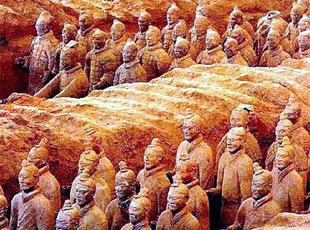| Tools: Save | Print | E-mail | Most Read |
| Experts Dismiss Warrior Mould Rumors |
| Adjust font size: |
Experts have refuted reports claiming that China's 2,000-year-old Terracotta Warriors are being destroyed by mildew. Media reports claimed last month that 48 species of potentially destructive mould had been detected on the relics, and would destroy them if they are not wiped out as soon as possible. "The truth is that the mould mainly grows on unearthed wooden sheds and earthworks in the pits where the warriors and horses were buried," said Zhao Kun, director of the Relics Preservation Department of Emperor Qinshihuang's Terracotta Warriors and Horses Museum. In addition, mildew, which only grows on organic materials such as wood, is unlikely to grow on the statutes as they are made of inorganic china clay, said Zhou Tie, the museum's senior researcher. More than 48 examples of mould have been found since 1994, said Zhao, but experts have developed technology to control its growth, which has largely been halted since 1998. "Since 1998, mould-control work has shifted from rescue and restoration to prevention, and now we can confidently say mould is no longer a problem," Zhou told Xinhua News Agency. According to Zhou, the temperature and humidity inside the pits have been controlled in order to prevent mould from growing, and air and earth quality is regularly monitored. Effective fungicides against scores of mould species have also been developed jointly by experts from the museum and Belgium's Janssen Pharmaceutical Co, a world leader in mould control. And number 1, 2 and 3 pits are now equipped with anti-mould instruments and monitoring devices, Zhou said. According to Zhao, rumors about harmful mould on the Terracotta Warriors followed reports that the museum and Janssen signed an agreement for further cooperation in relics protection in October. "The agreement is just the second stage of the long-term cooperation between the museum and the company," said Zhao. According to Zhao, the museum launched an anti-mould program with Janssen in 2000, with the research mainly focusing on anti-mould measures and technology for large ancient ruins and sites. "With a donation of US$1.42 million from Janssen, the current cooperation aims to further promote the museum's relic protection, research and technical development, including studies on relics' materials, environmental protection at ancient sites, relics restoration and the training of technical staff," said Wu Yongqi, director of the museum.
(China Daily December 2, 2006)
|
| Tools: Save | Print | E-mail | Most Read |
 |
| Related Stories |
|
|
Product Directory China Search |
Country Search Hot Buys |
